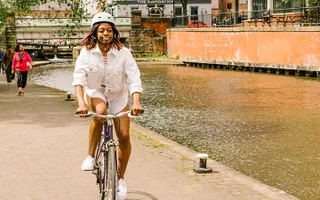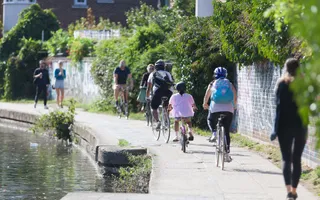Why have you updated the Towpath Code?
Our towpaths are more popular than ever before, so we want to set out clear guidelines on how best to use them. The new Code does this. There are new types of vehicles available today, such as e-bikes and e-scooters, so we wanted to make sure that the rules are clear on this too.
Why do pedestrians have prioirty?
The Trust has been promoting a pedestrian priority on towpaths since 2012, as a simple way of encouraging everyone to give more protection to those that are moving slow or who might be more vulnerable. In essence it's up to anyone who is moving faster, such as those on cycles or running for example, to watch out for wildlife, pets, and anyone acting as pedestrian (walking, standing, fishing or handling boats for example). The Highway Code also shares the same principle, after changes in 2020, although as towpaths are not roads the Highway Code does not apply.
Why are towpaths 'Shared Spaces'?
Towpaths were originally designed for a horse to pull a barge, but they're used for many more things that that these days. To access boats, angling, launching paddle boards, walking an cycling are all common place activities so unlike other paths that are simply just routes, towpaths need to be used more flexibly. Treating them as 'shared spaces' achieves this. They're generally too narrow to have lanes so it's up to everyone to use their commons sense, slow down and follow the Towpath Code.
Why isn't there a speed limit on towpaths?
Most people use common sense and take it easy on towpaths, so we don't think that speed limits are necessary. As all towpaths are different it wouldn't be possible or make sense to apply a blanket speed limit and as cycles do not have speedometers like cars do so it wouldn't be possible to enforce a speed limit.
What is a legal e-bike?
A legal e-bike is one that meets EAPC (electrically assisted pedal cycle) regulations and has not been modified in anyway. It must come with a pedal-assist motor and have a maximum power output of 250 watts. The electrical assistance must cut off when it reaches 15.5mph / 25kmph, and it cannot be ridden by anyone under the age of 14. For clarity if you have an electric bike with a ‘twist and go' throttle (that can be propelled without pedalling) this is NOT a legal e-bike, it is not allowed on towpaths and can be confiscated by the police if done so.
Why aren't e-scooters allowed on towpaths?
It's not currently legal to ride an e-scooter in any public place, except for where rental trails are being held. We've not allowed any trails to take place on towpaths. We issued this statement on e-scooters in 2020. This makes it clear that e-scooters are prohibited under our bylaws and that we will not be allowing e-scooters to be used on towpaths unless it can be proved that it is safe to do so. As yet, we have not seen such evidence.
Do I have to keep my dog on a lead on a towpath?
We ask all dog owners to make sure their dogs are under control and they clean up after them, but we do not specify that they have to be on a lead. In practice, of course, most dogs do need to be on a lead to be under control to ensure that they don't chase other pets, wild animals, birds or cause a nuisance to other towpath users. In some places, local bylaws do require dogs to be on a lead so please make sure you have followed any local signs.
What happens if someone isn't following the Towpath Code?
Most people take it easy on towpaths and follow the Towpath Code, but sometimes people are a bit forgetful or are simply in a hurry – which is why we put up signs and run the Share the Space, Drop your Pace campaign to remind and educate people. Instances where people regularly break the Towpath Code, we work with local authorities and the police. If you want to report an incident to us you can do so here.
Are all towpaths suitable for cycles, wheelchairs and mobility aids?
Our towpaths are mostly over 250 years old so whilst we've upgraded a lot of routes there are some that we've not had the funds to be able to improve. To learn more about the conditions in your area please see our accessibility map.
Do you have to use a bell on your bike?
Using a bell on towpaths is not required by law, but it is common sense. It's a considerate way to let other people know that you're there if they can't see you. Remember that some people who use the towpath may be hard of hearing and may not be able to hear your bell.
What should I do if I have or witness an accident at the canal?
As in all public places, the emergency services are your first port of call should an accident occur that requires medical or emergency attention. The emergency services may, in turn, require our assistance.
Sometimes it can be difficult to describe where you are on a towpath to emergency services so it's helpful to let them know the nearest landmark such as a lock, a bridge or a road. Alternatively, you can also use the What 3 Words app to pinpoint your position.
Once any immediate concerns have been dealt with, then please visit our reporting page which explains how best to report these incidents to us.
Can I use Strava or other apps on towpath?
Of course! It's fine to use apps on a towpath, but in the case of Strava (or other apps that allow virtual racing) we'd ask you not to ride fast, complete or try for personal bests on towpaths – they're simply not the right place for this. If you want to go fast, choose a different route with a real challenge, such as the Kentish Hills or the Tour de Yorkshire?
If you do see that a segment has been set up on a towpath, please make it as unsuitable for racing. You can read more about Strava's standards here.





